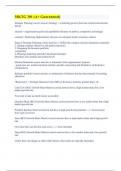Summary
Samenvatting Farmacologie partim I
- Course
- Institution
Samenvatting van het volledige eerste deel van farmacologie. Dit deel wordt gegeven door professor Guns, samen met de studierichtingen farmacie en biomedische. Op de eerste 2 pagina's is de inhoudstafel terug te vinden. Op het einde van het document zitten zowel de voorbeeldvragen als antwoorden di...
[Show more]












